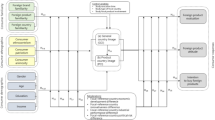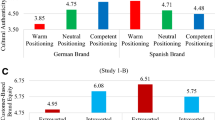Abstract
In this empirical article, we examine if and how national stereotypes based on perceptions of warmth versus competence affect consumers’ expectations about the hedonic versus utilitarian nature of products by employing a between-subjects experimental design on a US consumer sample. Results demonstrate that higher perceived warmth results in greater expectations of hedonic product properties, and that higher competence perceptions result in greater expectations of utilitarian properties. Importantly, we further show that warmth and competence consumer perceptions of nations mediate the effect of country-of-origin (COO) on hedonic and utilitarian product expectations, respectively. To the best of our knowledge, the study provides the first empirical verification in the COO literature that national stereotype contents (warmth and competence perceptions) actually drive consumer expectations of products. Our findings hold significant implications for the marketing strategies of nations as they position their products, investment and tourism offerings in a highly competitive nation-brand perceptual space. Further practical implications are recommended for global consumer brands.
Similar content being viewed by others
References
Aaker, J. (1997) Dimensions of brand personality. Journal of Marketing Research 34 (August): 347–357.
Aaker, J., Vohs, K. and Mogilner, C. (2010) Nonprofits are seen as warm and for-profits as competent: Firm stereotypes matter. Journal of Consumer Research 37 (August): 224–237.
Baron, R. and Kenny, D. (1986) The moderator-mediator distinction in social psychological research: Conceptual, strategic, and statistical considerations. Journal of Personality and Social Psychology 51 (6): 1173–1182.
Bilkey, W. and Nes, E. (1982) Country-of-origin effects on product evaluation. Journal of International Business Studies 13 (1): 89–99.
Chattalas, M. (1999) The Olympics and national image promotion. Proceedings of the Ninth Biennial Conference on Marketing History. Ann Arbor, MI, pp. 265–275.
Chattalas, M., Kramer, T. and Takada, H. (2008) The impact of national stereotypes on the country-of-origin effect: A conceptual framework. International Marketing Review 25 (1): 54–74.
Cohen, J. (1992) White consumer response to Asian models in advertising. Journal of Consumer Marketing 9 (2): 17–28.
Cuddy, A. (2008) Warmth and competence as universal dimensions of social perception: The stereotype content model and the BIAS map. Advances in Experimental Social Psychology 40 (March): 61–149.
Cuddy, A., Fiske, S. and Glick, P. (2004) When professionals become mothers, warmth doesn’t cut the ice. Journal of Social Issues 60 (December): 701–718.
Devine, P. (1989) Stereotypes and prejudice: Their automatic and controlled components. Journal of Personality and Social Psychology 56 (1): 5–18.
Dhar, R. and Wertenbroch, K. (2000) Consumer choice between hedonic and utilitarian goods. Journal of Marketing Research 37 (1): 60–71.
Diamantopoulos, A. and Zeugner-Roth, K. (2011) Country-of-origin as brand element. In: D. Bello and D. Griffith (eds.) Wiley International Encyclopedia of Marketing, Vol. 6, New York: Wiley, pp. 18–22.
Fiske, S., Cuddy, A., Glick, P. and Xu, J. (2002) A model of (often mixed) stereotype content: Competence and warmth respectively follow from perceived status and competition. Journal of Personality and Social Psychology 82 (6): 878–902.
Fiske, S., Xu, J., Cuddy, A. and Glick, P. (1999) Respecting versus liking: Status and interdependence predict ambivalent stereotypes of competence and warmth. Journal of Social Issues 55 (3): 473–489.
Freeman, B. and Nguyen, T. (2012) Seeing Singapore: Portrayal of the city-state in global print media. Place Branding and Public Diplomacy 8 (May): 158–169.
Fournier, S. (1998) Consumers and their brands: Developing relationship theory in consumer research. Journal of Consumer Research 24 (4): 343–373.
Gertner, D. (2011) A tentative meta-analysis of the ‘place marketing’ and ‘place branding’ literature. Journal of Brand Management 19 (2): 112–131.
Han, M. (1989) Country image: Halo or summary construct? Journal of Marketing Research 26 (2): 222–229.
Heslop, L. and Papadopoulos, N. (eds.) (1993) But who knows where or when: Reflections on the images of countries and their products. In: Product-Country Images. New York: International Business Press.
Heslop, L., Papadopoulos, N., Dowdles, M., Wall, M. and Compeau, D. (2004) Who controls the purse strings? A study of consumers’ and retail buyers’ reactions in an American FTA environment. Journal of Business Research 57 (10): 1177–1188.
Hong, S.-T. and Wyer, R. (1989) Effects of country-of-origin and product-attributes: Information on product evaluation: An information processing perspective. Journal of Consumer Research 16 (1): 175–187.
Jaffe, E. and Nebenzahl, I. (1993) Global promotion of country image: Do the Olympics count? In: N. Papadopoulos and L. Heslop (eds.) Product-Country Images. New York: International Business Press.
Jaffe, E. and Nebenzahl, I. (2006) National Image and Competitive Advantage. Copenhagen, Denmark: Copenhagen Business School Press.
Judd, C., James-Hawkins, L., Yzerbyt, V. and Kashima, Y. (2005) Fundamental dimensions of social judgment: Understanding the relations between judgments of competence and warmth. Journal of Personality and Social Psychology 89 (December): 899–913.
Klein, J., Ettenson, R. and Morris, M. (1998) The animosity model of foreign product purchase: An empirical test in the people's republic of China. Journal of Marketing 62 (1): 89–100.
Leclerc, F., Schmitt, B. and Dubé, L. (1994) Foreign branding and its effects on product perceptions and attitudes. Journal of Marketing Research 31 (4): 263–270.
Li, W-K. and Wyer Jr, R.S. (1994) The role of country of origin in product evaluations: Informational and standard-of-comparison effects. Journal of Consumer Psychology 3 (2): 187–212.
Lin, M., Kwan, V., Cheung, A. and Fiske, S. (2005) Stereotype content model explains prejudice for an envied outgroup: Scale of Anti-Asian American stereotypes. Personality and Social Psychology Bulletin 31 (1): 34–47.
Magnusson, P., Westjohn, S. and Zdravkovic, S. (2011) ‘What? I thought Samsung was Japanese’: Accurate or not perceived country of origin matters. International Marketing Review 28 (5): 454–472.
Maheswaran, D. (1994) Country of origin as a stereotype: Effects of consumer expertise and attribute strength on product evaluations. Journal of Consumer Research 21 (1): 354–365.
Mano, H. and Oliver, R. (1993) Assessing the dimensionality and structure of the consumption experience: Evaluation, feeling and satisfaction. Journal of Consumer Research 20 (2): 451–466.
Nocera, J. (2008) China tries to solve its brand X blues. New York Times, 12 April.
Park, W., Jaworski, B. and MacInnis, D. (1986) Strategic brand concept-image management. Journal of Marketing 50 (4): 135–145.
Pharr, J. (2005) Synthesizing country-of-origin research from the last decade: Is the concept still salient in an Era of global brands. Journal of Marketing Theory & Practice 13 (4): 34–45.
Poppe, E. and Linssen, H. (1999) In-group favouritism and the reflection of realistic dimensions of difference between national states in Central and Eastern European nationality stereotypes. British Journal of Social Psychology 38 (1): 85–102.
Ries, A. and Trout, J. (2001) Positioning: The Battle for your Mind. New York: McGraw-Hill.
Shimp, T. and Sharma, S. (1987) Consumer ethnocentrism: Construction and validation of the CETSCALE. Journal of Marketing Research 24 (3): 280–289.
Usunier, J.-C. (2011) The shift from manufacturing to brand origin: Suggestions for impoving COO relevance. International Marketing Review 28 (5): 486–496.
Verlegh, P. and Steenkamp, J.-B. (1999) A review and meta-analysis of country-of-origin research. Journal of Economic Psychology 20 (5): 521–546.
Voss, K., Spangenberg, E. and Grohmann, B. (2003) Measuring the hedonic and utilitarian dimensions of product attitude. Journal of Marketing Research 40 (3): 310–320.
Yeung, C. and Wyer, R. (2004) Affect, appraisal, and consumer judgment. Journal of Consumer Research 31 (1): 412–424.
Acknowledgements
The authors acknowledge the contribution of Dr Thomas Kramer to earlier versions of this article.
Author information
Authors and Affiliations
Corresponding author
Additional information
1received his PhD from The City University of New York and is Assistant Professor and Academic Program Coordinator at the School of Management, Marketing and International Business, Kean University. His research on consumer perceptions and national stereotyping, luxury value, sustainability and cross-cultural perspectives has been published in journals such as International Marketing Review and Journal of Consumer Marketing and presented at international conferences. He has extensive teaching experience in international executive education in Singapore, Taiwan and Hong Kong.
2received his PhD from Purdue University and is Professor of Marketing and International Business at the Zicklin School of Business, Baruch College, City University of New York. His research investigates competitive marketing behavior and advertising, international marketing research and analysis of diffusion processes and has been published in numerous scholarly journals, including Journal of Marketing, Journal of Business Research and Journal of International Marketing.
Rights and permissions
About this article
Cite this article
Chattalas, M., Takada, H. Warm versus competent countries: National stereotyping effects on expectations of hedonic versus utilitarian product properties. Place Brand Public Dipl 9, 88–97 (2013). https://doi.org/10.1057/pb.2013.5
Received:
Revised:
Published:
Issue Date:
DOI: https://doi.org/10.1057/pb.2013.5




